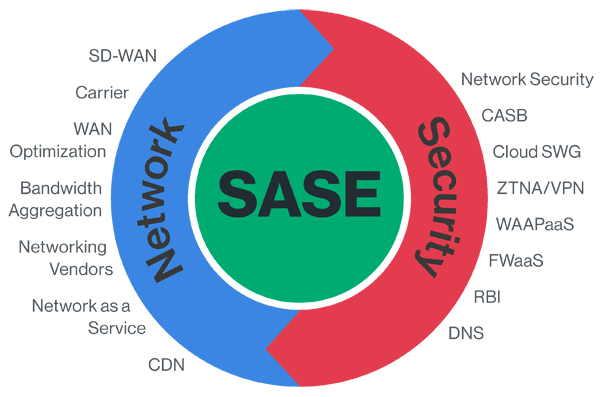Secure Access Service Edge (SASE) is a term most of us have heard one way or another. SASE framework can significantly increase network security, provide effective remote access, and better network performance.
Although IT professionals and enthusiasts know the concept, people who relate SASE to real-life cases are much less. SASE is a great security framework that shouldn’t be missed by any business owner or IT security personnel, so we listed the top three use cases of the model.
What is Secure Access Service Edge (SASE)?
SASE security framework was first introduced by Gartner in the report “The Future of Network Security Is in the Cloud.” The name of the report reveals the goal; SASE is mostly focused on cloud-based network security.
One thing to remember is that the SASE framework is not a product on its own. It’s a comprehensive security architecture combining security and network connectivity services. It creates a single structure where all these tools work together.
SASE uses wide-area networking (WAN) for connectivity and cloud-based security services such as the Zero Trust model, FWaaS, or CASB. By doing so, a architecture guarantees security on every part of a network.
Modern businesses use cloud tools and they need to provide continuous, fast, and secure access to their employees. Moreover, these companies hire remote team members.
Conventional security frameworks based on hardware are not capable of providing security for remote access or cloud services.
Since the boundaries where cloud services reach are non-existent, ensures edge-to-edge security by delivering the verification to the doorstep of users. SASE is not limited by location or device, and validation is possible anywhere, anytime.
Three use cases of SASE
SASE security framework is a highly useful model for most online businesses. Providing edge-to-edge security without sacrificing user experience is certainly a great deal. Before we explain the three use cases of SASE, click here to learn more about it.
1-) Safe transition to remote work
Remote work constitutes more than 15% of the total workforce. It is without a doubt a growing trend, and cybersecurity must follow it closely to protect networks against recent threats.
SASE architecture is a great way to bring security to the remote work models since its security and connectivity services are mostly operated in the cloud. They don’t require locationally limited hardware and can be used anywhere.
SASE framework also provides constant remote verification principles such as the Zero Trust, leaving no questions about remote security. As they’re cloud-oriented, remote access will also be faster than any other security framework.
2-) Controlled cloud adoption
Cloud-based services are becoming more popular as they save data more effectively and provide better overall network service. But migration to the cloud is not always easy, and companies might struggle moving their whole network to the cloud at once.
Without a robust and comprehensive security framework like SASE, cloud adoption might risk your network. Luckily, SASE allows companies to gradually migrate to the cloud while protecting the integrity and the availability of their network.
During the process of cloud adoption, you’ll have a hybrid network structure where some tools and services are on-premise and some are on the cloud. SASE framework is also capable of running hybrid networks without sacrificing security.
3-) Simplifying network security
Traditional network security approaches usually include several tools being operated separately and monitored manually. This requires a lot of manual work and keeps your IT security team from focusing on more important issues.
But the thing is, network security doesn’t have to be that complex. framework brings all the security services together in a single architecture. Thus, your IT department can control the whole network and all activities from a single point.
Also, centralizing network and security management reduces operational complications, especially if you get all the services from a single VPN provider. You can easily access login and off record, activities within the network, or the data being used. All of these will facilitate the job of your IT department.
Spending less time on security while getting the highest level of protection is not always possible. What’s better is that combining these security services also reduces costs.
Conclusion
SASE architecture is a great way to increase network security. Since its debut in 2019, it’s been a hit on the cybersecurity market. The modernization of the networks and increasing demand for cloud computing impacted its popularity.
You can benefit a great deal from a architecture, especially if your company network uses cloud services or has remote employees. Combining network connectivity and security is the perfect way to protect these companies from cyber threats.
If you want to migrate to a remote work model, move your network to the cloud, or just simplify network security, SASE is probably the best answer. Cybersecurity is always evolving, and now is the time to adopt SASE to keep up with the pace.
